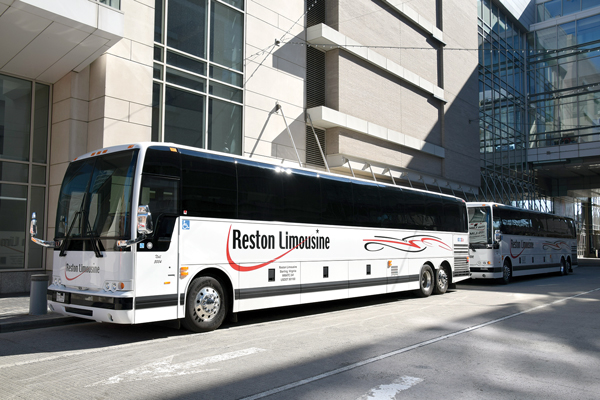BY SUSAN ROSE
 In January, more than one million people—and millions more at nationwide protests—descended upon the nation’s capital to protest the first full day of President Donald Trump’s presidency. The event, billed as the Million Women March, was noteworthy in that it was a convergence of so many different people, mostly women, from all walks of life and political persuasion for a common cause.
In January, more than one million people—and millions more at nationwide protests—descended upon the nation’s capital to protest the first full day of President Donald Trump’s presidency. The event, billed as the Million Women March, was noteworthy in that it was a convergence of so many different people, mostly women, from all walks of life and political persuasion for a common cause.
One of the many reasons for the event’s success—funny pink hats and fiery celebrity speeches aside—was the extreme ease of getting transportation to D.C.: Using bus crowdsourcing companies like Rally and Skedaddle, attendees were able to purchase a single seat or join with a few friends for a handful of seats rather than dealing with renting a private bus, relying on public transportation like Amtrak or Metro, or driving their own vehicles to the already overwhelmed city (although some did all of the above). Websites and social media quickly spread the word and drove demand.
This type of service isn’t new; Greyhound uses the single-seat paradigm. But it is a newer concept for our industry: Traditionally, an entire bus is booked for a single group, and a point person signs the contact to be responsible for filling the bus and collecting money. With crowdsourcing sites, a single person can propose a trip, which is then shared publicly with all local users through the site, and if enough riders sign on, the trip is booked through a charter or bus company.
Leros Point to Point was one of several companies that sent buses to D.C. for the rallies through Skedaddle. “January is usually the slowest month for buses, and that was a great two-day event that generated a lot of income that we wouldn’t have otherwise had,” says Jeff Nyikos, president of Leros.
He says that he started working with Skedaddle roughly six months ago after he read an article about the Boston-based company.
 “It’s a win-win situation because we’re looking for new niches and opportunities, and Skedaddle is obviously looking to grow their business. We’re all just trying to find new avenues of revenue for our vans, buses, or minibuses. They are really catering to Millennials and creating events for them, not unlike what Uber is doing. Most people who are using Uber never were our customers, but they’ve introduced a type of our service to a new generation of people.”
“It’s a win-win situation because we’re looking for new niches and opportunities, and Skedaddle is obviously looking to grow their business. We’re all just trying to find new avenues of revenue for our vans, buses, or minibuses. They are really catering to Millennials and creating events for them, not unlike what Uber is doing. Most people who are using Uber never were our customers, but they’ve introduced a type of our service to a new generation of people.”
This type of service is driven by and marketed heavily to Millennials. For example, Lindsay Dougherty, director of marketing for Skedaddle, says that they often work directly with events and destinations that have those transportation needs, such as music festivals or ski resorts, and cross-promote it with their own database of users who happen to skew younger and tend to be in or a few years removed from college. The demand is driven through social media and digital platforms as well as through grassroots efforts within the college community, such as sororities or clubs.
Ridesharing evokes a strong negative reaction in our industry—and with good reason. Unlike TNCs, however, many of these crowdsourcing sites are doing it the right way: by partnering with vetted, legally operating transportation companies. For companies like Skedaddle, that means checking for DOT compliance, reviewing driver safety and training records, examining maintenance plans, and confirming that the company has a preferred $5 million insurance policy, according to Skedaddle Director of Operations Hayden Broberg. The system currently has more than 200 operators across the country. Skedaddle was a first-time exhibitor at the Chauffeur Driven Show in 2016, and Broberg, who just recently attended another industry show, says that she’s taken notice of the increase in buses within our industry in just the short time that Skedaddle has been in existence.
Most people who are using Uber never were our customers, but they’ve introduced a type of our service to a new generation of people."
– Jeff Nyikos, President of Leros Point to Point
“We’ve been really lucky to meet some amazing operators and they refer us to people when we enter a new market. Skedaddle is here to work in a mutually beneficial way where we’re activating new riders and bringing different revenue streams to operators. We’re not looking to decrease anyone’s profits or margins. We’re just looking for approaches to work together to combine technology and transportation in an advantageous way,” says Broberg.
The benefits to using these types of crowdsourcing aggregators have been on the backend: reducing the legwork to put tours like this together and the advertising that goes with it, while being exposed to potentially new Millennial clientele. However, companies like Reston Limousine have been successful with their own single-seat model through public offerings like wine and brew tours. Instead of acting only as the fulfillment company—they do, on occasion, work with aggregators—Reston handles it all.
“We’ve been doing it for so long now that we have it down to a science,” says Carolyn Callahan, director of sales at Reston. While its most popular public tours are to local vineyards, Reston also spearheads trips to New York, the Philadelphia Flower Show, university transportation for sporting events, and even self-guided D.C. tours with the single-seat model. The company manages its own website interface so that customers can log in and purchase their individual seat. It’s a little more work that can easily be automated.
Setting the price point, especially right out of the gate, is going to be trial and error for each operator because it has to be attractive to customers while still turning a profit—which can be a bit tricky when you have a lot of competition in your market for the same type of service. Callahan says that companies can get creative by bundling the admission and transportation price, or negotiating with the venue or event for discount tickets that can be passed on to customers. For public trips that have less competition but high demand, she says that you can charge a little more.
Customers are willing to spend more for an experience because that’s what you are selling—not just transportation."
– Carolyn Callahan, Director of Sales Reston Limousine
But, she warns, it shouldn’t just be about price. “If you’re only competing on price, you’re going to have to come up with a unique offering. The discriminator on our public wine tours is the relationships that we have built with wineries because that’s what makes the experience for our customers. It’s the preplanning that makes it work: We handle the reservation, the wineries are expecting us, and we’re treated special. Many companies have wine tours but don’t do them well; some wineries don’t welcome the crowds or busloads at a time. Customers are willing to spend more for an experience because that’s what you are selling—not just transportation.”
Callahan says that selling individual seats isn’t limited to public tours; she’s also had requests of the same payment method with private groups. “We’ve had family reunions come to us and want to set up individual payments because one person in the family does not want to be responsible for having to collect all that money, or it’s a hassle with cash. I never carry cash, and it’s just easier to pay with my card. Someone typically has to stand up and organize it, so when you take that burden off the customer and allow pay per seat, it’s easier for everyone. They love it, it’s automated, and it’s easy.”
Aggregators are also listening to what transportation providers are requesting and working with them to offer their own trips. “One of the most exciting things about Skedaddle is that we are heavily invested in learning about the industry. We’ve noticed a trend where operators really do want to make their own trips so the operations team at Skedaddle is working to find a solution where operators can propose trips and then blast it out to their existing customer base. I think it’s a tremendous opportunity for both our users and operators,” says Broberg.
Nyikos agrees that it’s a smart trend, and is looking to set up a similar system for wine tours in the near future. “As an industry, we need to come up with some new niche markets, and this is one that I think could be successful for us. Companies like Skedaddle have their own database of riders, but there’s no reason that our industry can’t do the same thing with our current clients,” he says. [CD0417]

